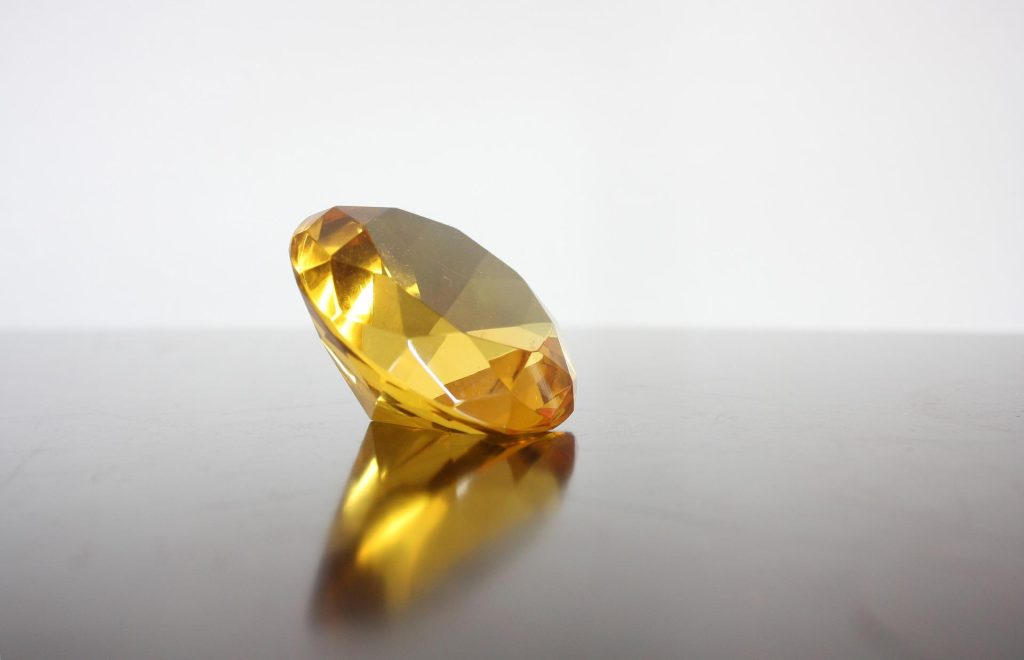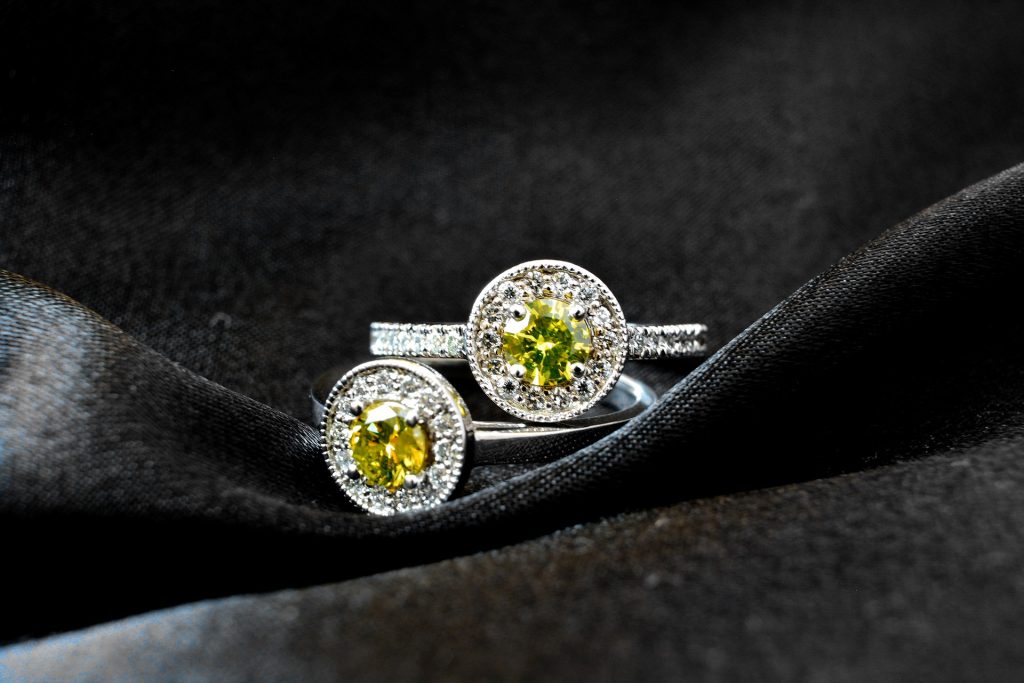When most people think of an engagement ring, they envision a colorless, white diamond with plenty of radiance and brilliance. Yellow diamond rings have become increasingly popular with consumers in recent years, thanks to their popularity among celebrities.
When deciding between a VS diamond ring and a GIA-certified fancy yellow diamond, the most important consideration is the color. Natural diamonds are colorless and display an extremely bright appearance, whereas lab-grown diamonds are typically colorless. If you are looking for a ring that reflects light well, the clarity grade of the diamond will be the most important factor. You should also consider the price.

Choosing Between a VS Diamond Ring and a GIA Certified Fancy Yellow Diamond
The “VS” designation is the highest clarity classification, with a very small number of visible inclusions. These are so small that they cannot be seen with the naked eye. When the stone is set in an engagement ring, “VS” diamonds are eye clean and have no visible flaws. They also are the least expensive choice for a ring and are often less expensive. VS clarity grades are the lowest in price, so be sure to shop around.
VS diamonds have a smaller percentage of noticeable imperfections. They are eye-clean, but may have a few visible spots or scratches. They are also less expensive than an SI diamond, and are usually eye-clear. It is best to opt for an VS diamond if the size and shape of the stone are important to you. They are usually eye-clean, but have imperfections visible when magnification is used.
VS clarity is the best choice for a ring with a VS diamond. VS clarity diamonds are eye-clean in real life and are often less expensive than IF or SI diamonds. You may also want to opt for a VS2 diamond if the clarity is more important to your partner than the price. But remember, VS1 and VS2 diamonds are both eye-clean, so you don’t need to worry about this when purchasing a ring.
VS clarity is the lowest of the three clarity grades. VS clarity diamonds are often more affordable than IF and GI diamonds. They are easier to see compared to IF and SI diamonds. The GIA certification will determine the type of ring your partner is likely to wear. Regardless of whether it’s an emerald, a VS quality stone will be an excellent investment.
VS clarity is the best choice for most people. This grade is considered a good choice for rings, but its appearance is not always eye-clean. There are several reasons why a VS clarity diamond is the best choice. VS quality is the best value. It will last longer and will be more beautiful than any other ring you can buy. You can save up to 70% on your engagement ring by purchasing a VS certificate.
VS Diamond Ring
What is a VS Diamond, & How Does it Differ from Other Diamonds?
The “VS” designation in a diamond stands for “Very Small” inclusions. But just because they’re there doesn’t mean you’ll be able to see them. In fact, 10x magnification is frequently required to detect these flaws. If you aren’t using a jeweller’s loupe, the diamond will most likely be clean to the naked eye. That implies you won’t be able to spot flaws with your naked eye.
A diamond can be “VS1” or “VS2” clarity within the VS category. The flaws in a VS1 diamond are tiny and difficult to notice. A VS2 clarity diamond, on the other hand, will rarely have any flaws discernible to the human eye.
Is a VS Diamond the Best Choice for me?
Your budget, the diamond shape you want, and your buying style will all play a role in determining whether or not you should buy a VS diamond. You can choose VS clarity or a different grade once you’ve learned how to evaluate these characteristics.
Budget Clarity: VS or SI
Diamonds having a lesser clarity grade, such as SI, or “Slightly Included,” will obviously be less expensive than VS diamonds. Consider a diamond with a SI1 or perhaps SI2 clarity if you want the largest diamond that appears perfect to the human eye.
Diamond Clarity and Shape
Depending on your preferred diamond shape, a high clarity grade such as VS may be a better choice. The majority of diamond shapes are “brilliant cuts,” which effectively mask flaws. The popular round, princess, and cushion cuts are included. Emerald and asscher-cut diamonds, on the other hand, are “step cuts,” which disclose flaws more readily.
If you want a step-cut diamond, select the greatest VS1 or VS2 clarity stone you can afford.
What Kind of Shopper are you?
A VS clarity diamond can be a great choice if you don’t like shopping and just want to get something immediately. There are usually no noticeable flaws in these diamonds. So, if the price difference isn’t a factor, choose a VS. Just be sure there isn’t a huge, black inclusion in the diamond’s core. These are the most noticeable imperfections. They could even be visible in an engagement ring or other piece of jewellery.
Should I Purchase a Diamond with VS Clarity?
For the most part, VS clarity is a fantastic choice for most diamond consumers. There are almost no noticeable flaws in these stones. Their prices are also significantly lower than those of diamonds with superior clarity.
Yellow Diamonds: What are They?
Yellow diamonds are one of many different types of Fancy Colored Diamonds that can be found in nature and man-made settings. Fancy colours, such as yellow diamonds, present an interesting and tempting alternative to clear and colourless diamonds. Because of a small amount of nitrogen in their structure, they have a gorgeous golden colour.
Diamonds that are entirely clear and colourless attract a greater price than diamonds that have a yellowish hue, which is often regarded as a negative feature. As a Fancy Colored Diamond, however, its value rises as the hue reaches a point where yellow is the dominating colour.
Shades of other colours, such as orange or brown, may be found in fancy yellow diamonds. Yellow diamonds with a pure, vivid yellow colour, on the other hand, are the most sought and precious. Canary Diamonds, or Canary Yellow Diamonds, are the name given to these pure yellow diamonds.
Canary Diamonds, so named because their colour is similar to that of a canary bird, are the most valuable of all yellow diamonds, commanding the highest price.
Yellow Diamonds’ Origin
The presence of nitrogen in yellow diamonds gives them their distinct colour. Because the nitrogen molecules absorb blue light, the stone appears yellow. A yellow diamond can be pale or dark depending on the amount of nitrogen present.
Additional colours, such as the usual brown or orange tint observed in yellow diamonds, are caused by different compounds present during the diamond’s creation. These diamonds, known as Canary Diamonds, are extremely rare due to the natural process required for a diamond to achieve a deep, bright yellow tint.
Is it True That Yellow Diamonds are Uncommon?
Colored diamonds that are naturally coloured are extremely rare. A natural coloured diamond is found in only one out of every 10,000 carats. The romantic pinks and purples, the dazzling blue, the interesting green, the lively orange, and, of course, the shiny and brilliant yellows are among the rainbow of hues.
Yellow diamonds are the most frequent in the colour diamond niche. According to estimates, they account for up to 60% of coloured diamonds. However, to put things in perspective, a yellow diamond accounts for about 1 out of every 16,500 carats mined, indicating that yellow diamonds are extremely rare.
Is it True That Yellow Diamonds are More Expensive?
A good grade white diamond, such as one of G colour, costs around the same as a fancy yellow diamond. The price of a white diamond in larger and rarer sizes is more comparable to that of a fancy intense yellow diamond than to that of a fancy yellow diamond.
Consider a 3 carat diamond: a 3 carat G colour diamond costs around $40,000, whereas a 3 carat fancy yellow diamond costs “just” approximately $20,000 and a fancy intense $25,000-$40,000. A 5 carat G colour diamond costs around $100,000, a 5 carat fancy yellow diamond costs $40,000-$60,000, and a 5 carat fancy intense diamond costs $80,000-$120,000.
What are the 4C’s & How do They Affect Yellow Diamond Prices?
It is quite difficult to determine and evaluate the price of a diamond, any diamond. In the case of white colourless diamonds, you use a price list (which fluctuates a lot) and add or deduct all other characteristics from the price (hint: not only the 4cs of diamonds).
However, determining the value of a coloured diamond necessitates a high level of skill. The rationale is simple to comprehend.
The presence of a brownish tinge in a yellow diamond will significantly diminish its value, whereas green or orange will significantly raise it.
The colour is the first thing we look at when grading yellow diamonds (as it is with other coloured diamonds). While some may argue that clarity and colour are comparable in terms of how they influence the price and value of colourless diamonds, the pricing of coloured diamonds (particularly yellow diamonds) begins with the hue. We’ll start with it because it’s by far the most significant.
Conclusion
A gorgeous yellow diamond is comparable to a white, colourless diamond and is less expensive. When compared to pink or red diamonds, it is a more economical option that can help you stand out.
Remember to look for a diamond that has been properly certified by GIA, as this ensures that the stone has not been treated and that the diamond’s quality has been precisely appraised. I’d like to hear from you now. Which would you select if you had to choose between a yellow diamond and a white diamond engagement ring, and why?







